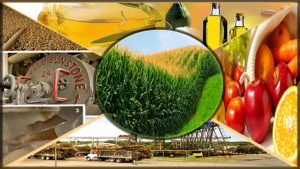 Decomposition of rocks and minerals by various chemical processes is called chemical weathering. It is the most important process for soil formation.
Decomposition of rocks and minerals by various chemical processes is called chemical weathering. It is the most important process for soil formation.
Chemical weathering takes place mainly at the surface of rocks and minerals with disappearance of certain minerals and the formation of secondary products (new materials). This is called chemical transformation.
Feldspar + water -> clay mineral + soluble cations and anions
Chemical weathering becomes more effective as the surface area of the rock increases.
Since the chemical reactions occur largely on the surface of the rocks, therefore the smaller the fragments, the greater the surface area per unit volume available for reaction.
The effectiveness of chemical weathering is closely related to the mineral composition of rocks. (e.g.) quartz responds far slowly to the chemical attack than olivine or pyroxene.
Average mineralogical composition (%)
Composition | Granite | Basalt | Shale | S. Stone | L. Stone |
Feldspar | 52.4 | 46.2 | 30.0 | 11.5 | – |
Quartz | 31.3 | – | 2.3 | 66.8 | – |
Pyrox – amphi | – | 44.5 | – | – | – |
FeO mineral | 2.0 | 9.3 | 10.5 | 2.0 | – |
Clay mineral | 14.3 | – | 25.0 | 6.6 | 24.0 |
Carbonates | – | – | 5.7 | 11.1 | 76.0 |
Chemical Processes of weathering:
1. Hydration: Chemical combination of water molecules with a particular substance or mineral leading to a change in structure.
Soil forming minerals in rocks do not contain any water and they under go hydration when exposed to humid conditions. Up on hydration there is swelling and increase in volume of minerals. The minerals loose their luster and become soft.
It is one of the most common processes in nature and works with secondary minerals, such as aluminium oxide and iron oxide minerals and gypsum. (e.g.)
a) 2Fe2O3 + 3HOH -> 2Fe2O3 .3H2O
(Hematite) (Red) (Limonite) (Yellow)
b) Al2O3 + 3HOH -> Al2O3 .3H2O
(Bauxite) (Hyd. aluminium Oxide)
c) CaSO4 + 2H2O -> CaSO4 .2H2O
(Anhydrite) (Gypsum)
d) 3(MgO.FeO.SiO2) + 2H2O -> 3MgO.2SiO2.2H2O + SiO2 + 3H2O
(Olivine) (Serpentine)
2. Hydrolysis: Most important process in chemical weathering. It is due to the dissociation of H2O into H+ and OH- ions which chemically combine with minerals and bring about changes, such as exchange, decomposition of crystalline structure and formation of new compounds. Water acts as a weak acid on silicate minerals.
KAlSi3O8 + H2O -> HAlSi3O8 + KOH
(Orthoclase) (Acid silt clay)
HAlSi3O8 + 8 HOH -> Al2O3 .3H2O + 6 H2SiO3
(Recombination) (Hyd. Alum. oxide) (Silicic acid)
This reaction is important because of two reasons.
clay, bases and Silicic acid – the substances formed in these reactions – are available to plants
water often containing CO2 (absorbed from atmosphere), reacts with the minerals directly to produce insoluble clay minerals, positively charged metal ions (Ca++, Mg++, Na+, K+ ) and negatively charged ions (OH-, HCO3-) and some soluble silica – all these ions are made available for plant growth.
3. Solution: Some substances present in the rocks are directly soluble in water. The soluble substances are removed by the continuous action of water and the rock no longer remains solid and form holes, rills or rough surface and ultimately falls into pieces or decomposes. The action is considerably increased when the water is acidified by the dissolution of organic and inorganic acids. (e.g) halites, NaCl
NaCl + H2O -> Na+, Cl- , H2O (dissolved ions with water)
4. Carbonation: Carbon dioxide when dissolved in water it forms carbonic acid.
2H2O + CO2 -> H2CO3
This carbonic acid attacks many rocks and minerals and brings them into solution. The carbonated water has an etching effect up on some rocks, especially lime stone. The removal of cement that holds sand particles together leads to their disintegration.
CaCO3 + H2CO3 -> Ca(HCO3)2
(Calcite) slightly soluble (Ca bi carbonate) readily soluble
5. Oxidation: The process of addition and combination of oxygen to minerals. The absorption is usually from O2 dissolved in soil water and that present in atmosphere. The oxidation is more active in the presence of moisture and results in hydrated oxides.(e.g) minerals containing Fe and Mg.
4FeO (Ferrous oxide) + O2 -> 2Fe2O3 (Ferric oxide)
4Fe3O4 (Magnetite) + O2 -> 6Fe2O3 (Hematite)
2Fe2O3 (Hematite) + 3H2O -> 2Fe2O3 .3H2O(Limonite)
6. Reduction: The process of removal of oxygen and is the reverse of oxidation and is equally important in changing soil colour to grey, blue or green as ferric iron is converted to ferrous iron compounds. Under the conditions of excess water or water logged condition (less or no oxygen), reduction takes place.
2Fe2O3 (Hematite) – O2 -> 4FeO( Ferrous oxide) – reduced form
In conclusion, during chemical weathering igneous and metamorphic rocks can be regarded as involving destruction of primary minerals and the production of secondary minerals.
In sedimentary rocks, which is made up of primary and secondary minerals, weathering acts initially to destroy any relatively weak bonding agents (FeO) and the particles are freed and can be individually subjected to weathering.
Original Article Here







